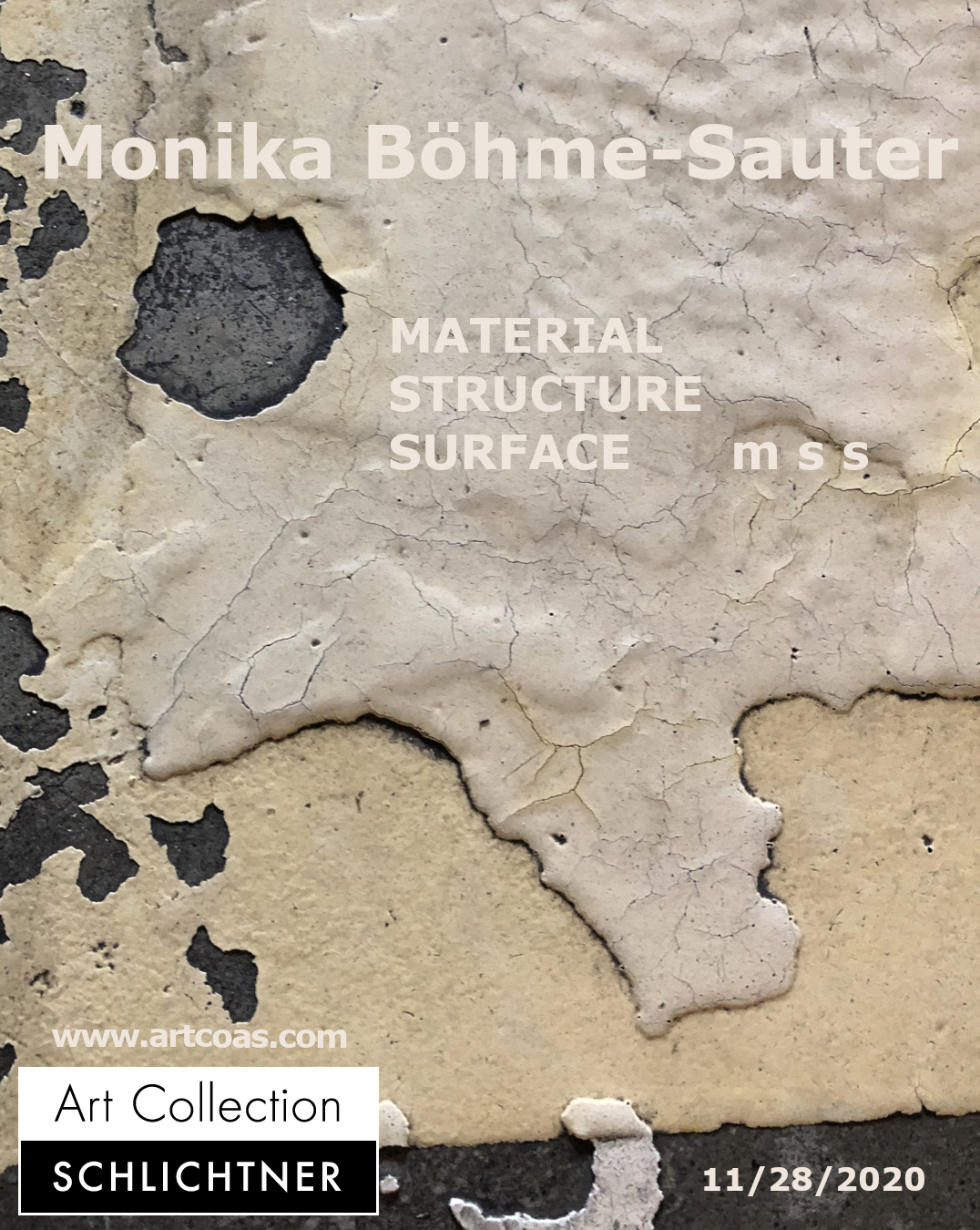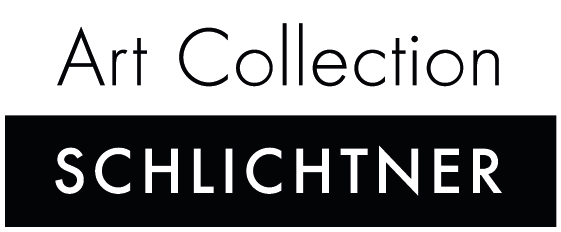Monika Böhme-Sauter and Art Collection Schlichtner - Interview - 25.11.2020

Fotocredit: Photo courtesy of Monika Böhme-Sauter
Interview 25.11.2020 Monika Böhme-Sauter and Andreas Schlichtner
Andreas: “Hello Monika, how did your artistic career begin? Were your parents artists or collectors? Has anyone in the family influenced you?“
Monika: “There is definitely an influence here! Both of my parents are untrained artists, but my father has always dedicated himself to art and also collected art and took me to all of the studios. It was often two or three in the morning, and as a small child I got a place to sleep somewhere in the studio. I often didn't like it that much, but the atmosphere there definitely influenced me. Then we often went to Paris and I saw everything from the Louvre to the Musée D'Orsay. That was an influence. My father always painted. I also saw how my father painted and I smelled the oil paints. And my father's brother, who unfortunately died at the age of fourteen, was a very talented drawer. I still have a little book in which there are drawings by him that he made when he was thirteen. You can't imagine that, Andreas! I'm not exaggerating now! And a cousin of mine who lives in Vienna paints a lot. I have painted myself since I was a child. I don't know if that's interesting, but it was very colorful and I had two exhibitions and also sold something. Back then I attached enlarged photos to a plate and then painted on them. And my father had to change jobs late for family reasons, that was difficult, and he then had a painting of me hanging in his office and some wanted to buy it.”
Andreas: “Did you have other role models in addition to your family environment?”
Monika: “At the time when I painted in such colors, I didn't have any role models at all. But when I then studied art history, I was extremely impressed by Albrecht Dürer. But that has nothing to do with my art.”
Andreas: “So you decided to study art history?”
Monika: “I went to the University of Applied Arts and wanted to study art but applied unsuccessfully. They said, I should come back after a year and change a few things in my art. But they liked the colors. But I didn't want to burden my parents for another year. I then leafed through the course catalog and my friend at the time asked me if I am interested in art history. And then he went to Graz and that became my art history studies in Graz.”
Andreas: “And here Albrecht Dürer was the great aha experience.”
Monika: “Yes exactly. Also the woodcuts and portraits. I remember that forever. And through the lecture “Art in Public Space” I was drawn more and more to contemporary art, of course. I also came into contact with contemporary art through the exhibitions in Vorarlberg and Liechtenstein. I've seen good exhibitions here, e.g. by Jannis Kounellis. That's when I came up with it, yes that captivates me. Then I saw sewing machines with a patina. That goes in the direction of how I now take photos. Then there was an excursion to New York. Then I gave the lecture on Max Beckmann and his triptych “Die Abfahrt/The Departure”. Then I went to the Guggenheim Soho and saw Tapies. And that totally captivated me. I saw him again in Barcelona and it really impressed me. He has attached bags and jute to the painting.”
Andreas: “And did you make art back then when you were studying art history?”
Monika:”Yes. I painted for a year after breaking up with my boyfriend. Lots of small format pictures. But then I took a break. Then I did something like Tapies. Then the color gave way.”
Andreas: “What was it that fascinated you? And how did you develop further? What does your art look like that you are doing today? Where are you now?”
Monika: “So from then on I was fascinated by the material, structure and surface. In my thesis on Tone Fink I had that as a subtitle. Because he also worked on the paper surfaces, some of which tore open. With a sharp pencil, he called it a scribble, he attacked the surface of the paper. And that fascinated me. From then on I was fascinated by the material, structure and surface. It started even earlier when my father was selling Vitra fiberglass furniture. The structure - that was my topic. And that was also the case with Tapies. It doesn't have a smooth surface. And from then on, I started again after the long break of ten years. And now in the Corona time I suddenly thought, I'll start again. I discovered tracing paper for myself because it has a different effect depending on where it is lying or hanging, on the floor, on the wall, in front of the window. That really fascinated me. Also because tracing paper changes again when it gets wet or when the color soaks in, it becomes wavy and gets a structure. That's part of the art that I do now and then came the surfaces. I discovered these containers in an abandoned area. I thought to myself: I'll just take a picture now. I noticed, aha, if I take it out in detail, it becomes even more expressive than as a whole. And there I have the full color inside, but not at all in painting. I've always been interested in photography, so I thought about studying it. And then I'm interested in the various surfaces such as plastic films and jute. And now I've discovered photography. And then I want to paint into the photos.”
Andreas: “I find two aspects here that are interesting. First the Corona time, because it has had a positive effect on some artists. They have started to get really active. And they are increasingly using social media.”
Monika: “Yes that comes now!”
Andreas: “And you must have thought that this is a great medium to put it online and spread it.”
Monika: “It was like this. I was standing under a large electricity pylon and I thought to myself that I have to stand under it now. I said to my companion, sorry, I now have to go into the field and take photos of the electricity pylon from below. And those were the first photos that I put in. And people reacted insanely to that. I made them happy. I liked Instagram, put it on and had success. Then luckily I came across your site. Then I started taking more photos because of the recognition and the comments. And so the phase came with photography and surfaces.”
Andreas: “Yes, I also find this aspect exciting, that you can capture multidimensional and relief-like surfaces in a two-dimensional photo. It's not that easy, is it? You don't just show the detail, but also the whole object in the series. Of course, it would also be exciting to show the detail only, then the secret would be a little bigger.”
Monika: “I'm interested in the surfaces where parts overlap. I generally take photos from the front, then from the side, then completely from the side or from the very bottom to the top.”
Andreas: “If you zoom in all the way you get the effect of a painted picture. But something is also lost in the process, you don't know where it came from, and that's also interesting to know and what kind of object it is, whether it has decayed and changed. You want to capture the change!”
Monika: “That’s important. I don't just want to show the details, but the whole too. Now I remember something else about the surface: an influence that I have from my childhood. The parental home is on Roman land and a school was built on the neighbouring property. As a child I made Roman finds there while digging. Then I found coins with the patina, all turquoise. And from there, I believe, comes the love of the surface. Other children were also happy about the coins, but I especially liked the surface. That always said something to me. I was about six years old then.”
Andreas: ”I see a parallel to your approach today. You discovered the coins, just as you find your photo motifs on old industrial sites today. You go on a journey of discovery. Then you examine it and catch something and hold on to it. You are still interested in the rusted areas, just like the patinated coins back then.”
Monika: “The nature that worked on this is fascinating. And then I like the colors again. The natural colors and what nature does with the basic colors of the objects.”
Andreas: “Very exciting! Dear Monika, thank you for the interview!”
